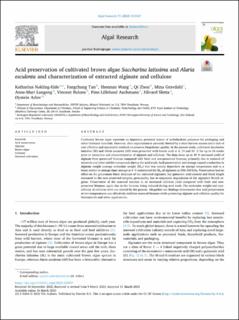| dc.contributor.author | Nøkling-Eide, Katharina | |
| dc.contributor.author | Tan, Fangchang | |
| dc.contributor.author | Wang, Shennan | |
| dc.contributor.author | Zhou, Qi | |
| dc.contributor.author | Gravdahl, Mina | |
| dc.contributor.author | Langeng, Anne-Mari | |
| dc.contributor.author | Bulone, Vincent | |
| dc.contributor.author | Aachmann, Finn Lillelund | |
| dc.contributor.author | Sletta, Håvard | |
| dc.contributor.author | Arlov, Øystein | |
| dc.date.accessioned | 2024-02-08T09:36:44Z | |
| dc.date.available | 2024-02-08T09:36:44Z | |
| dc.date.created | 2023-04-12T10:27:42Z | |
| dc.date.issued | 2023 | |
| dc.identifier.citation | Algal Research. 2023, 71 . | en_US |
| dc.identifier.issn | 2211-9264 | |
| dc.identifier.uri | https://hdl.handle.net/11250/3116316 | |
| dc.description.abstract | Cultivated brown algae represent an important potential source of carbohydrate polymers for packaging and other biobased materials. However, their exploitation is currently limited by a short harvest season and a lack of cost-effective and sustainable methods to preserve biopolymer quality. In the present study, cultivated Saccharina latissima (SL) and Alaria esculenta (AE) were preserved with formic acid at 4, 13 and 20 °C for up to 16 weeks prior to extraction and characterization of alginate and cellulose. The data show up to 40 % increased yield of alginate from preserved biomass compared with fresh and non-preserved biomass, primarily due to removal of minerals and other soluble compounds during the acid wash. Acid preservation and storage caused a reduction in alginate weight average molecular weight (Mw) that was mainly dependent on storage temperature and to a lesser extent on storage time; storage at 4 °C maintained the Mw of alginates at 350–500 kDa. Preservation had no effect on the guluronate block structure of the extracted alginates, but guluronic acid content and block length increased in the non-preserved samples, presumably due to enzymatic degradation of the alginate's M-rich regions. Preservation of the seaweed resulted in an increased cellulose yield compared with fresh and non-preserved biomass, again due to the biomass being reduced during acid wash. The molecular weight and crystallinity of cellulose were not altered by the process. Altogether our findings demonstrate that acid preservation at low temperatures can effectively stabilize seaweed biomass while preserving alginate and cellulose quality for biomaterials and other applications. | en_US |
| dc.language.iso | eng | en_US |
| dc.publisher | Elsevier B. V. | en_US |
| dc.rights | Navngivelse 4.0 Internasjonal | * |
| dc.rights.uri | http://creativecommons.org/licenses/by/4.0/deed.no | * |
| dc.title | Acid preservation of cultivated brown algae Saccharina latissima and Alaria esculenta and characterization of extracted alginate and cellulose | en_US |
| dc.title.alternative | Acid preservation of cultivated brown algae Saccharina latissima and Alaria esculenta and characterization of extracted alginate and cellulose | en_US |
| dc.type | Peer reviewed | en_US |
| dc.type | Journal article | en_US |
| dc.description.version | publishedVersion | en_US |
| dc.source.volume | 71 | en_US |
| dc.source.journal | Algal Research | en_US |
| dc.identifier.doi | 10.1016/j.algal.2023.103057 | |
| dc.identifier.cristin | 2140194 | |
| dc.relation.project | Norges forskningsråd: 226244 | en_US |
| dc.relation.project | Norges forskningsråd: 294946 | en_US |
| dc.relation.project | Norges forskningsråd: 311958 | en_US |
| dc.source.articlenumber | 103057 | en_US |
| cristin.ispublished | true | |
| cristin.fulltext | original | |
| cristin.qualitycode | 1 | |

